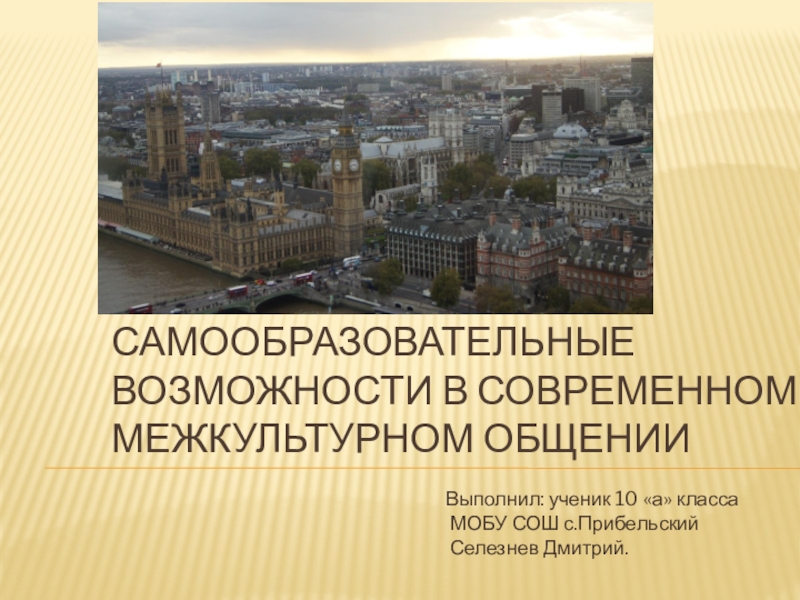Made by V. P. Simatova.
- Главная
- Разное
- Образование
- Спорт
- Естествознание
- Природоведение
- Религиоведение
- Французский язык
- Черчение
- Английский язык
- Астрономия
- Алгебра
- Биология
- География
- Геометрия
- Детские презентации
- Информатика
- История
- Литература
- Математика
- Музыка
- МХК
- Немецкий язык
- ОБЖ
- Обществознание
- Окружающий мир
- Педагогика
- Русский язык
- Технология
- Физика
- Философия
- Химия
- Шаблоны, фоны, картинки для презентаций
- Экология
- Экономика
Презентация, доклад к уроку на тему Мир возможностей 10 кл.
Содержание
- 1. Презентация к уроку на тему Мир возможностей 10 кл.
- 2. The Top 10Best Medical Schools There are thirty
- 3. BARTS AND THE LONDON SCHOOL OF
- 4. UNIVERSITY OF BIRMINGHAM MEDICAL SCHOOLThe University of Birmingham Medical School
- 5. BRISTOL MEDICAL SCHOOLBristol Medical School is prevalently
- 6. BRIGHTON AND SUSSEX MEDICAL SCHOOL Brighton and
- 7. SCHOOL OF CLINICAL MEDICINE, UNIVERSITY OF CAMBRIDGE
- 8. DURHAM UNIVERSITY SCHOOL OF MEDICINE AND HEALTHDurham University School
- 9. HULL YORK MEDICAL SCHOOLThe Hull York Medical
- 10. IMPERIAL COLLEGE SCHOOL OF MEDICINE Imperial College School of Medicine is
- 11. KEELE UNIVERSITY SCHOOL OF MEDICINEKeele University School
- 12. KING’S COLLEGE LONDON SCHOOL OF MEDICINE AND DENTISTRYKing’s
- 13. Used Internet resources:http://bsmy.ru/3405http://medicine.hofstra.edu/giving/index.htmlhttp://en.wikipedia.org/wiki/Barts_and_The_London_School_of_Medicine_and_Dentistryhttp://en.wikipedia.org/wiki/University_of_Birmingham_Medical_Schoolhttp://en.wikipedia.org/wiki/Bristol_Medical_Schoolhttp://en.wikipedia.org/wiki/Brighton_and_Sussex_Medical_Schoolhttp://listscafe.com/education/top-10-best-medical-schools-universities-in-united-kingdom-uk/http://en.wikipedia.org/wiki/School_of_Clinical_Medicine,_University_of_Cambridgehttp://en.wikipedia.org/wiki/Durham_University_School_of_Medicine,_Pharmacy_and_Healthhttp://en.wikipedia.org/wiki/Hull_York_Medical_Schoolhttp://en.wikipedia.org/wiki/Imperial_College_School_of_Medicinehttp://en.wikipedia.org/wiki/Johns_Hopkins_School_of_Medicinehttp://en.wikipedia.org/wiki/King's_College_London_School_of_Medicinehttp://listscafe.com/education/top-10-best-medical-schools-universities-in-united-kingdom-uk/
Слайд 1Medical education in the UK
Top 10 best medical schools,
Universities in the
Слайд 2The Top 10Best Medical Schools
There are thirty two medical schools in the United
There are twenty four schools in England, two in Wales, and five in Scotland and one in Northern Ireland. The Top 10Best Medical Schools, Universities in United Kingdom UK List is provided below.
Слайд 3
BARTS AND THE LONDON SCHOOL OF MEDICINE AND DENTISTRY
are the therapeutic and dental school of the
In Great Britain physicians are trained in either medical schools or faculties of Universities. To enter a medical school in Great Britain candidates must pass entrance examinations. Entrance examinations are both oral and written. Students take these examinations at the end of their 6-year secondary-school course, generally at the age of 18-19 years. For entrance to a faculty of medicine or a medical school, it is required that the subjects of chemistry, physics and biology or mathematics should be taken at the advanced level. Tuition fees are charged. Most students receive financial assistance in the form of grants, which cover their expenses wholly or in part.
Слайд 4UNIVERSITY OF BIRMINGHAM MEDICAL SCHOOL
The University of Birmingham Medical School is solitary of Britain’s
The academic year is divided into 3 terms, each of 10-11 weeks' duration. The terms run from October to December, from January to March and from April to June. Clinical students, however, attend for 48 weeks of the year. Undergraduate education occupies five years, consisting essentially of two years of basic sciences and three years of clinical work.
Слайд 5BRISTOL MEDICAL SCHOOL
Bristol Medical School is prevalently acknowledged for its MB
Two pre-clinical years are occupied by human anatomy and biology, physiology and biochemistry. They also study physiology, statistics and genetics. Students attend lectures, do dissections and practical work in labs. Latin is not taught in all medical schools. English and Latin spellings are similar and it is possible to write out prescriptions in English too.
Слайд 6BRIGHTON AND SUSSEX MEDICAL SCHOOL
Brighton and Sussex Medical School is a therapeutic school
Beginning with the third year the students study the methods of clinical examinations and history taking, general pathology, microbiology, pharmacology and community medicine. Senior students and especially undergraduates spend most of their time in teaching hospitals, which have both in-patient and out-patient departments, or units. Daily bedside instruction in hospital wards and out-patient departments is given by teachers and doctors. Students follow up their patients and attend ward rounds. Besides the work in the wards the students attend demonstrations and clinical conferences as well as lectures in clinical subjects which are being studied.
Слайд 7SCHOOL OF CLINICAL MEDICINE, UNIVERSITY OF CAMBRIDGE
The School of Clinical Medicine
Examinations in medical schools are held at the end of each term. In our case it is three times a year. At the end of each term and after each special course students take final exams. They are called sessionals. Most of the exams are written. They include academic and practical problems. The final examinations or finals are in Medicine, Surgery, Obstetrics and Gynecology and Pathology. Finals also include history taking and diagnosing. Before finals in Surgery students assist in operations.
Слайд 8DURHAM UNIVERSITY SCHOOL OF MEDICINE AND HEALTH
Durham University School of Medicine and Health was
Before finals in Obstetrics and Gynecology they must assist during the delivery of at least 20 babies. These examinations are both written and oral. Written test includes short and long questions and questions of multiple choice. Oral tests include diagnosing a case. So three years are spent in clinical studies to obtain. degrees of Bachelor of Medicine (MB) and Bachelor of Surgery (BS). The degrees of Bachelor of Medicine and Bachelor of Surgery give the right to register as a medical practitioner.
Слайд 9HULL YORK MEDICAL SCHOOL
The Hull York Medical School is a medicinal
After the finals graduates work in hospitals for a year. This period is called internship. The newly qualified doctor must serve for six months as a house physician and six months as a house surgeon under the supervision of his medical school. House physicians and surgeons are on call every second or third night. The work of interns is very difficult and their salary is very small. After internship a young doctor obtains a «Certificate of Experience» from the medical school and he or she may work as a medical practitioner.
Слайд 10IMPERIAL COLLEGE SCHOOL OF MEDICINE
Imperial College School of Medicine is the therapeutic instruct of Imperial College London
Further specialization requires training in residency. It takes one or two years of work in a hospital in some field. Residency trains highly qualified specialists in a definite field: gynecologists, urologists, neurologists and others. The salary of residents is higher than the salary of interns. After residency a specialist gets rather a high salary.
Слайд 11KEELE UNIVERSITY SCHOOL OF MEDICINE
Keele University School of Medicine is established
Besides the degrees of MB and BS, in the UK they have the degree of Doctor of Medicine (MD). This degree is a postgraduate qualification obtained by writing a thesis based on original work. It is not required for practice. Such a degree in surgery is termed a mastership (MS)».


















